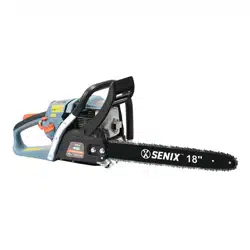Loading ...
Loading ...
Loading ...

4 WWW.SENIXTOOLS.COM
19. Do not operate a chain saw when you
are fatigue.
20. Do not allow other persons to be near
the chain saw when starting or cutting
with the chain saw. Keep bystanders
and animals out of the work area.
21. When transporting your chain saw, use
the appropriate guide-bar scabbard.
22. All chain saw service, other than the
items listed in the instruction manual(s)
maintenance instructions, should be
performed by competent chain saw
service personnel. (For example, if
improper tools are used to remove the
flywheel or if an improper tool is used
to hold the flywheel in order to remove
the clutch. Structural damage to the
flywheel could occur and subsequently
could cause the flywheel to burst.)
1. Always switch the product off and let
the product cool down, before refueling
it. Fuel and fuel vapor are highly
flammable. Take care when handling
fuel. Never smoke when you are
refueling the product. Do not refuel the
product, if there is an open fire in the
vicinity!
2. Always use suitable aids such as
funnels and filler necks. Do not spill
any fuel on the product or its exhaust
system. There is a risk of ignition.
Remove spilled fuel carefully from all
parts of the product. Move the unit a
safe distance from the refueling point
before starting.
3. Keep the handles dry, clean, and free
of oil or fuel
4. Never use the product in environments
where there is a risk of explosion.
Exhaust gases and fuel fumes are
noxious. Fuel fumes can ignite.
5. Never fill the tank in enclosed spaces,
such as basements or sheds. There is
a risk of poisoning and explosion!
6. Avoid skin contact with gas.
7. Do not eat or drink, while you are
refueling the product. If you have
swallowed gas or oil, or if gas or oil
has gotten into your eyes, then seek
medical attention.
8. Close the tank lid immediately after
filling the tank. Make sure that it is
properly closed.
9. Never use the product without an air
filter.
10. Fuel vapor pressure may build up
inside the fuel tank depending on the
fuel used, weather conditions and the
tank venting system. To reduce the risk
of burns and other personal injuries,
remove the fuel cap carefully to allow
any pressure built up to release slowly.
11. Be aware of fire risks, explosion and
inhalation risks.
12. Ensure the spark plug lead is secured;
a loose lead may cause electrical
arcing that could ignite combustible
fumes and cause a fire or explosion.
13. Check regularly for leaks from the fuel
cap and fuel lines.
14. Tighten the fuel cap thoroughly after
refilling the fuel tank.
15. Do not operate the product if it is
leaking fuel. Do not remove the fuel
tank cap while the engine is running.
16. Use only an approved container.
17. Do not store cans of fuel or refill the
fuel tank in any place where there is
a boiler, stove, wood fire, electrical
sparks, welding sparks, or other
sources of heat or fire which might
ignite the fuel.
18. If you have spilled fuel on yourself or
on your clothes, change your clothes
and wash any part of your body that
has come in contact with fuel before
turning the engine on again.
19. If fuel is ignited, put out the fire with a
dry powder fire extinguisher.
20. If the fuel tank is drained, this should
be done outdoors.
21. Use caution when handling fuel. Move
the chain saw at least 10 feet (3 m)
from the fueling point before starting
the engine.
1. Do not operate the product indoors,
it produces poisonous exhaust fumes
while the engine is running and may be
colorless and odorless.
2. Do not wrap the recoil starter rope
around your hand while starting the
product. This may result in injuries to
your hand or fingers.
3. Keep handles dry, clean, and free from
Loading ...
Loading ...
Loading ...
